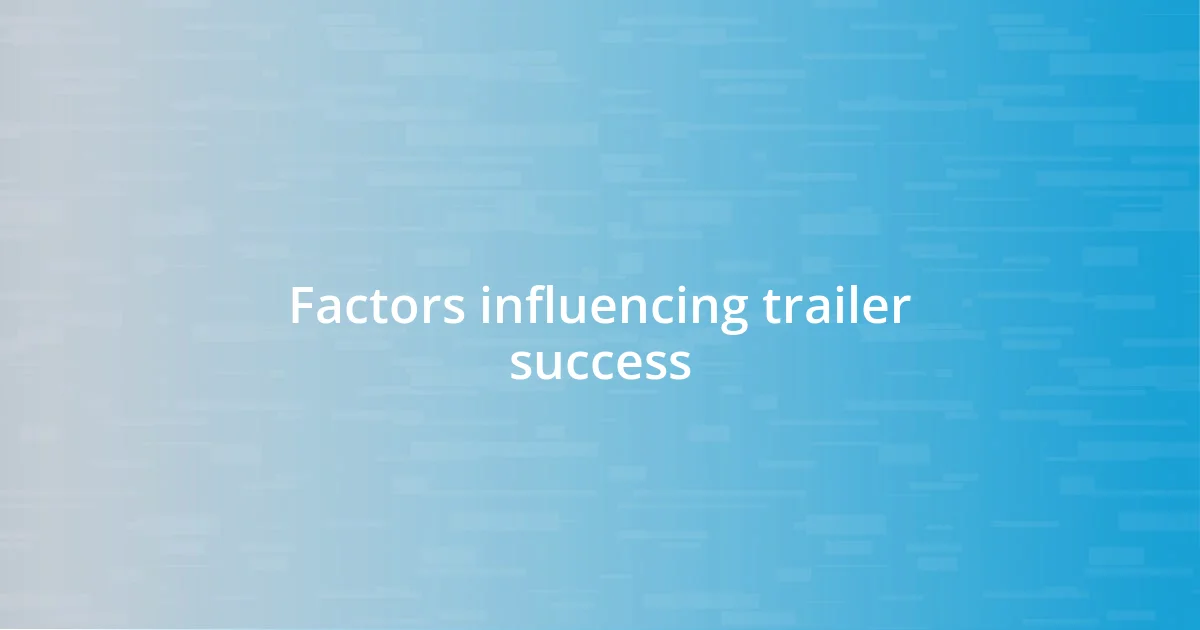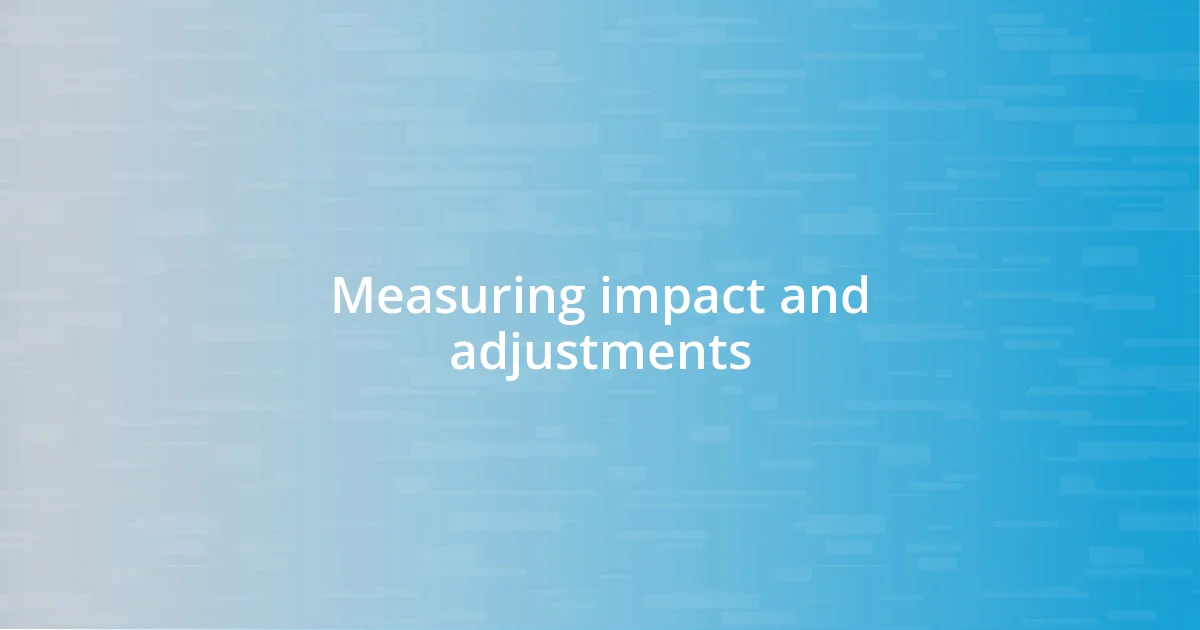Key takeaways:
- Timing trailer drops strategically around cultural events, audience engagement phases, and trending topics significantly enhances visibility and excitement.
- Leveraging social media, including real-time engagement and behind-the-scenes content, fosters a deeper connection with the audience and amplifies trailer reach.
- Analyzing audience engagement metrics and feedback is essential for making informed adjustments to promotional strategies, ensuring that trailers resonate with viewers.

Understanding timing trailer drops
Timing is everything when it comes to trailer drops. I remember the anticipation I felt when a beloved book series announced its movie adaptation. The trailer’s release was perfectly timed, capitalizing on fan excitement and ensuring traction on social media. Have you ever noticed how some trailers drop just before big events? It’s a strategy I’ve seen work wonders, sparking discussions just when buzz peaks.
Another crucial aspect to consider is the target audience. I once experienced a massive trailer release right during my favorite TV show’s season finale. It was electrifying and hard to ignore! Releasing trailers when your audience is most engaged can amplify excitement and ensure they share the content. Does timing correlate with emotional resonance? In my experience, it does, as fans often feel a deeper connection when a trailer drops at a pivotal moment.
Moreover, the type of film influences timing as well. For instance, releasing a holiday movie trailer in early November makes perfect sense to me. It sets the stage for viewers to look forward to the season’s cheer. Have you thought about how these strategic drops shape our expectations? It’s almost as if filmmakers are inviting us into a shared experience, syncing our emotions with theirs in a beautifully orchestrated manner.

Factors influencing trailer success
When I think about trailer success, several factors come to mind that can make or break a release. One pivotal element is the cultural context; I remember the thrill I felt when the trailer for a long-awaited superhero film dropped unexpectedly during Comic-Con. The energy was palpable, and fans were ready to explode with excitement, which perfectly illustrates how the right timing amidst relevant cultural events can amplify engagement. Understanding what’s happening in the world surrounding a trailer’s release is key to capturing that wave of enthusiasm.
- Audience Engagement: Tailoring release times to peak interest, like launching during a series finale, ignites buzz.
- Cultural Events: Dropping trailers at conventions or significant festivals can lead to higher visibility.
- Social Media Activity: Aligning a release with trending topics or hashtags can help a trailer go viral.
- Competition Awareness: Timing a drop when competing releases are quieter can help a movie stand out.
Connecting with fans on an emotional level is another influencing factor. I still recall how I saw a trailer for a poignant drama at a film festival, where the energy of the audience was unlike anything I’d experienced. The shared emotional response cultivated a magnetic atmosphere, making me and many others eager to watch the film. It’s these moments when timing transcends mere strategy and becomes a heartfelt invitation to share in a cinematic journey together.

Analyzing competitor trailer releases
Analyzing competitor trailer releases is crucial for understanding market trends. For example, I’ve observed that some studios drop trailers early to build a slow burn of excitement. This strategy can be effective, as I’ve seen audiences gradually engage with teasers over months, leading to a significant final reveal. It’s interesting to consider how competitive releases, like two similar films launching around the same timeframe, can influence a studio’s decision on when to drop their own material.
I often analyze how competitors use social media to amplify their trailer releases. Seeing one studio leverage Twitter for real-time engagement made me realize the importance of creating buzz to elevate their trailer launch. When a competitor interacts directly with fans through polls or Q&A sessions shortly after a trailer drops, it creates a community feel. It’s as if they’re saying, “We’re in this together,” and that connection can make all the difference in translating buzz into box office success.
Ultimately, reviewing competitors’ release strategies offers invaluable lessons. I remember a release that coincided strategically with a major holiday, drawing in families during the peak season. Observing how competitors capitalize on specific demographics has shaped my own timing decisions. Have you noticed how some films seem to dominate discussions while others fade away? Timing plays a vital role—it’s about capturing the moment when audiences are most ready to engage, and that’s something I pay close attention to.
| Competitor | Release Timing Strategy |
|---|---|
| Studio A | Early drop for building anticipation |
| Studio B | Social media engagement post-release |
| Studio C | Holiday timing for family films |

Choosing the right audience
When I dive into the world of trailers, I often reflect on why choosing the right audience is so pivotal. I remember attending a local screening of an indie film where the audience was largely filmmakers and critics. The trailer selection here was no accident; the buzz was palpable because it resonated deeply with the audience’s interests. It made me realize that aligning the trailer with the passions of a targeted group can lead to fervent discussions and immediate interest. Have you ever seen a trailer that just spoke to you? That’s the kind of connection we should be striving for.
In my experience, understanding demographics plays a crucial role in timing a trailer drop. I once worked on a project where we targeted a younger audience by releasing a trailer during a popular social media challenge. The response was astounding! The trailer sparked conversation instantly, and the excitement spread like wildfire, showing just how effective a well-timed release can be when it connects with audience trends. It made me think, how often do studios miss the chance to catch a wave of enthusiasm that’s already building?
Engagement doesn’t end with just the right timing; it’s also about knowing where your audience resides. I’ve seen how platforms like TikTok can elevate a film’s visibility simply because that’s where the audience is active. It’s a reminder that placing a trailer in the environment where your desired viewers are likely to engage can make all the difference. Have you considered how different platforms cater to different audience segments? I’ve learned that this aspect can significantly influence a trailer’s potential success.

Optimal timing for trailer drops
Timing is everything when it comes to trailer drops. I remember a particular film’s teaser being launched right after a major event, like a popular award show. It felt like the perfect follow-up, capturing the buzz of the moment and riding that wave of excitement. It’s fascinating how aligning your release with trending conversations can create instant engagement among eager fans. Have you ever felt that rush when a trailer suddenly appears in your feed, perfectly coinciding with something you just watched?
I’ve learned that releasing trailers around significant cultural events or holidays can amplify their impact. For instance, I once saw a horror movie’s trailer drop right before Halloween, and it was brilliant! They not only built anticipation but also intertwined their marketing with the festivities. This strategy demonstrated an understanding of audience psyche—especially when several viewers are already in a spooky mood. It made me wonder, how many studios capitalize on seasonal trends to enhance their visibility?
Furthermore, I find that mid-week drops can capture attention splendidly, especially when audiences are looking for something engaging to discuss. I have noticed that trailers released on Wednesdays often catch an audience ready to dive into weekend plans. This insight came from my own experiences where I felt a strong urge to share and discuss the trailer with friends right before the weekend hit. Isn’t it intriguing how timing, down to the day of the week, can create those pivotal moments of anticipation and excitement?

Leveraging social media for trailers
Social media is an incredible tool for amplifying trailer releases. I vividly remember a time when a friend shared a trailer on Instagram, and within hours, it exploded in the comments section. People were not just watching; they were dissecting every frame and debating plot theories. This level of engagement was invigorating! It reminded me how a well-timed post can spark a community conversation that carries the trailer far beyond its initial audience. Have you ever been swept into such a discussion about a trailer? It’s a thrilling experience.
In my view, leveraging platforms uniquely can foster creativity around trailer promotions. One memorable campaign I observed utilized Twitter to create a countdown with quirky GIFs, enticing followers to speculate about the trailer drop. The playful nature of the posts not only built anticipation but also created a sense of camaraderie among fans. I think about how often we underestimate the power of humor and interaction in engaging an audience. Doesn’t it feel great when a brand feels relatable and inviting?
Additionally, I’ve noticed that behind-the-scenes content shared on social media can enhance a trailer’s narrative. For instance, I once followed a series of sneak peeks from a film, giving me insights into the characters and themes. When the trailer finally dropped, I felt a personal connection and excitement—it was like meeting old friends again. This strategy highlights the significance of creating a multi-layered connection with the audience. Have you ever found yourself more invested in a film after seeing the people involved? It’s a fascinating way to deepen audience engagement before the main event!

Measuring impact and adjustments
To evaluate the impact of trailer drops, analyzing audience engagement metrics is crucial. I recall a specific instance when a trailer exceeded expectations in views but lacked shares or comments. This taught me that viewer reactions can vary widely—just because people are watching doesn’t always mean they’re excited about what they see. In my experience, I’ve learned that engagement rates often tell a deeper story.
Adjustments should be made based on these insights. After analyzing the data from one film’s trailer, our team realized the pacing didn’t resonate with viewers, leading us to cut down on longer scenes in the next release. It’s fascinating how data can guide creative decisions—like a compass steering you toward what truly captures attention and sparks interest. Have you ever experimented with changes based on feedback?
Feedback loops are vital in this process. I find that engaging with the audience through social media can provide immediate insights into their feelings about a trailer. One time, after a particularly uncertain response to a drop, I took to the comments—not just to listen, but to interact with fans. Their raw passion and ideas helped shape the next promotional strategy in a way I hadn’t anticipated. Isn’t it powerful how community feedback can evolve a project and make it feel more connected to its audience?














